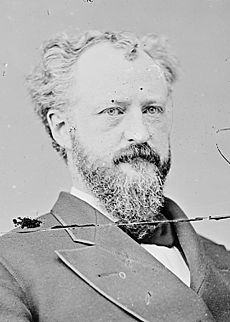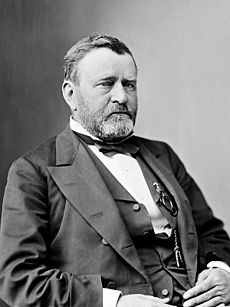Stalwarts (politics) facts for kids
Quick facts for kids
Stalwarts
|
|
|---|---|
| Leader | • Roscoe Conkling • Zachariah Chandler • Oliver P. Morton • Benjamin Butler • Thomas C. Platt • Chester A. Arthur • Levi P. Morton • John A. Logan • Simon Cameron • J. Warren Keifer • J. Donald Cameron • William O'Connell Bradley • William B. Allison • Frederick T. Frelinghuysen • Leonidas C. Houk |
| Founded | c. 1872–77 |
| Dissolved | c. 1890 |
| Preceded by | Radical faction of the Republican Party |
| Merged into | Republican Party |
| Ideology | • Radical Republicanism • Grantism • Pro-machine politics • Pro-spoils system • Conservatism • Pro-black suffrage • Sound money • Protectionism<• Waving the bloody shirt |
| Political position | Center-right to right-wing |
| National affiliation | Republican Party |
The Stalwarts were a group, or faction, within the Republican Party. They were active in the United States during and after the Reconstruction period and the Gilded Age. This was mainly in the 1870s and 1880s.
U.S. Senator Roscoe Conkling was their main leader. People sometimes called Stalwarts "Conklingites" after him. Other important Stalwarts included Chester A. Arthur and Thomas C. Platt. This group strongly supported Ulysses S. Grant, who was the 18th President of the United States. They wanted him to run for a third term in the 1880 United States presidential election.
James G. Blaine first used the name "Stalwart" for this group. He later led a rival group called the "Half-Breeds." Blaine and his political group sometimes worked with the Stalwarts. They supported giving government jobs to political friends, known as the spoils system. They also spoke up for Black Americans in the South. Blaine used the term "Stalwart" to praise Conkling's group. He saw them as very loyal to the Republican Party's ideas.
Stalwarts were seen as "traditional" or "Old Guard" Republicans. They supported the civil rights of African Americans. They did not agree with President Rutherford B. Hayes's plans to change the civil service system. This system aimed to hire government workers based on skill, not political connections.
The Stalwarts were often against the "Half-Breeds" in the Republican Party. The Half-Breeds were more moderate and wanted civil service reform. A big disagreement between them was over the spoils system, or patronage. The Half-Breeds worked to pass the Pendleton Civil Service Reform Act. This law helped end the spoils system. President Arthur signed it after James A. Garfield, a Half-Breed, was assassinated. Stalwarts liked the old ways of machine politics. This meant political groups controlled votes and jobs.
Contents
How the Stalwarts Formed
After the American Civil War, different groups within the Republican Party argued. These groups included "Radical Republicans," "Moderates," and "Conservatives." They disagreed on how to rebuild the South during Reconstruction. Radical Republicans wanted strong rules to protect the rights of newly freed slaves. They also wanted to promote a free-market economy in the South.
Over time, the power of the Radical Republicans faded. Many members became unhappy with corruption during Ulysses S. Grant's time as president. But some Radicals stayed strong in their beliefs. They continued to "wave the bloody shirt," which meant reminding people of the Civil War to gain support. They also kept fighting for Black civil rights. These remaining Radicals formed the Stalwarts. Important members included Roscoe Conkling, John A. Logan, and Chester A. Arthur.
What Stalwarts Believed
Stalwarts were best known for supporting Ulysses S. Grant for president. They wanted him to be re-elected. The 1880 Republican National Convention was a key event for them. Many Stalwarts at the convention were from former Confederate states. Others were from New York, Illinois, and Pennsylvania.
They were loyal to the policies of Grant's presidency. They supported "hard money," which meant money backed by gold or silver. They also favored high tariffs, which are taxes on imported goods. This protected American businesses. They continued to "wave the bloody shirt." They also supported Southern Republicanism led by freed slaves and carpetbaggers. Carpetbaggers were Northerners who moved to the South after the war.
Even though they were called "conservative," Stalwarts did not always agree on everything. Their main shared ideas were supporting the spoils system and Black civil rights. Some members, like John A. Logan, even wanted lower tariffs. This was different from the usual Republican view. Stalwarts were generally careful with new policies. They preferred to avoid controversial ideas. This is why they supported Grant, a popular former president, in 1880.
Stalwarts and President Hayes
Conkling Fights Hayes Over Jobs
The Collector of the Port of New York was a very powerful job. This person controlled a major trading hub for the United States. For many years, Senator Conkling's political machine controlled this important position. President Hayes tried to take control of the Port from Conkling. But Conkling stopped him.
Hayes tried twice to appoint his own people to the job. But Conkling rallied other Republicans in the Senate. They voted against Hayes's choices. One of Hayes's early choices was Theodore Roosevelt Sr., the father of a future president. Conkling and other Stalwarts, along with James G. Blaine, voted against him.
Conkling later managed to get his close ally, Chester A. Arthur, the job. Arthur would later become president.
Hayes Fires Arthur
Arthur's time in the Customs House was known for corruption. He often chose party loyalties over skills for jobs. He was said to ignore corruption. He also hired thousands of Republicans just because they were in his party.
In 1877, an investigation looked into the Customs House. The next year, President Hayes and Secretary of the Treasury John Sherman fired Arthur. Sherman was a Half-Breed. Even some members of the Blaine group criticized this decision. They started to move away from Hayes.
Hayes's administration then won some battles within the party. They successfully appointed Edwin Atkins Merritt and Silas W. Burt to important jobs in New York. Even though Republican opposition to Hayes lessened, the Stalwarts and Blaine group still disliked his reform ideas.
The 1880 Republican Convention
The 1880 Republican National Convention was a big event. In 1880, Stalwarts like Conkling, Logan, and Simon Cameron strongly pushed for Ulysses S. Grant to be president again. They wanted him to serve a third term, but not right after his second. The Half-Breeds wanted Senator George F. Edmunds to be nominated. The Blaine group wanted James G. Blaine as president.
Grant had tried some civil service reform before. But he became unhappy with Hayes's efforts to weaken the Stalwarts' power. Conkling, who was close to Grant during his presidency, became his main supporter again. The Stalwarts really wanted Grant to be nominated. They hoped he would serve a third term.
There was a lot of bitter fighting between Conkling's group and Blaine's group. Blaine's allies, William P. Frye and Eugene Hale, struggled to debate Conkling. Conkling was very clever and sometimes rude in debates.
No group could win enough votes for their candidate. So, the Blaine group and supporters of John Sherman made a deal. They agreed to nominate James A. Garfield as president. To please the Stalwarts, they chose Chester A. Arthur as his running mate. Arthur was a former Collector of the Port of New York and a Conkling ally.
Garfield first suggested John Sherman, a Half-Breed, for vice president. But to unite the party, Arthur became Garfield's running mate. Half-Breeds were upset and called Arthur "Conkling's creature." But the pair narrowly won the election in November.
Decline of the Stalwarts
After the Republican win in 1880, President Garfield and Conkling argued fiercely. They fought publicly over who would get government jobs in New York. Garfield, with help from Blaine, won this fight. Conkling and Platt resigned from the Senate. They thought they would easily be re-elected by the New York legislature. But they were wrong.
On July 2, 1881, a man named Charles J. Guiteau shot Garfield. Guiteau called himself a "Stalwart of the Stalwarts." Garfield died on September 19, 1881. Arthur then became President of the United States. The shock of the assassination broke Conkling's power and that of the Stalwarts.
President Arthur, who was once Conkling's friend, helped create civil service reforms during his term. He felt he needed to finish Garfield's work. The Pendleton Act passed with no Republican opposition in the Senate. Remaining Stalwart senators, like John A. Logan, voted for it. Only seven House Republicans voted against the Pendleton Act.
In the 1884 United States presidential election, Conkling and Platt did not support Arthur's re-election. The Republican nomination went to James G. Blaine. Conkling still disliked Blaine and refused to help him. Even though Stalwart John A. Logan was the vice presidential pick, Conkling would not campaign. When asked to help, Conkling famously said, "I don't engage in criminal practice."
In some states, like Wisconsin, the term "stalwart" was still used. It referred to the conservative part of the Republican Party. This continued into the 1930s, against the more progressive elements.
See also
 In Spanish: Stalwarts para niños
In Spanish: Stalwarts para niños
- James G. Blaine, a political leader who was often against the Stalwarts.



